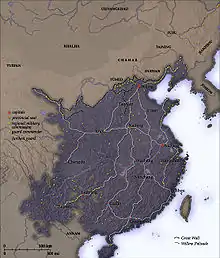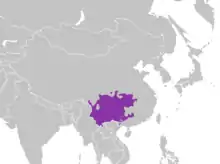Southwest China
Southwest China (Chinese: 西南; pinyin: Xīnán; lit. 'Westsouth') is a region in the south of the People's Republic of China, traditionally known as Southwest China due to its location in relation to historical China proper. The narrowest concept of Southwest China consists of Sichuan, Yunnan, and Guizhou, while wider definitions often include and Chongqing, Guangxi, and western portions of Hunan.[1] The official government definition of Southwest China includes the core provinces of Sichuan, Chongqing, Yunnan, and Guizhou, in addition to the Tibet Autonomous Region which has not traditionally been included as part of the region.
Geography
Southwest China is a rugged and mountainous region, transitioning between the Tibetan Plateau to the west and the Chinese coastal plains to the east. Key geographic features in the region include the Hengduan Mountains in the west, the Sichuan Basin in the north, and the karstic Yungui Plateau in the east. The majority of the region is drained by the Yangtze River which forms the Three Gorges in the northeast of the region.[2]
History

Portions of Southwest China were incorporated under Chinese influence as early as the 3nd century BCE in the Qin dynasty. Independent states would continue to exert influence within the region, with notable examples being the Nanzhao Kingdom in the 8th and 9th centuries CE and the Dali Kingdom in 10th and 11th centuries CE. By the time of the Ming Dynasty the region was largely pacified and incorporated into the Chinese domain.[1] During the Second Sino-Japanese War, the city of Chongqing served as the capital of Chinese resistance to imperial Japanese expansion.
Demographics
The diverse areas of Southwest China carry strong regional identities and have been historically considered more rural than the more developed eastern regions of China.[1] Rapid development since the late 1970s has helped transform many parts of the region with modern advancements. In the early 21st century, Southwest China contained 50% of the country's ethnic minority population which in turn formed 37% of the region's population.[1] Han Chinese migration has been largely concentrated in the urban centres while the rural areas are still predominantly made up by minority populations including the Zhuang, Miao, Yi, and others.

Inhabitants of Southwest China primarily speak a variant of Mandarin Chinese known as Southwestern Mandarin. This variant uses the same written language as Mandarin but is only approximately 50% mutually intelligible with Standard Chinese. As of 2012, there were approximately 260 million speakers of Southwestern Mandarin.[3]
Administrative divisions

| GB[4] | ISO №[5] | Province | Chinese Name | Capital | Population | Density | Area | Abbreviation/Symbol |
|---|---|---|---|---|---|---|---|---|
| CQ | 50 | Chongqing Municipality | 重庆市 Chóngqìng Shì |
Chongqing | 28,846,170 | 350.50 | 82,300 | 渝 Yú |
| SC | 51 | Sichuan Province | 四川省 Sìchuān Shěng |
Chengdu | 80,418,200 | 165.81 | 485,000 | 川(蜀) Chuān (Shǔ) |
| GZ | 52 | Guizhou Province | 贵州省 Gùizhōu Shěng |
Guiyang | 34,746,468 | 197.42 | 176,000 | 贵(黔) Guì (Qián) |
| YN | 53 | Yunnan Province | 云南省 Yúnnán Shěng |
Kunming | 45,966,239 | 116.67 | 394,000 | 云(滇) Yún (Diān) |
| XZ | 54 | Tibet Autonomous Region Xizang Autonomous Region |
西藏自治区 Xīzàng Zìzhìqū |
Lhasa | 3,002,166 | 2.44 | 1,228,400 | 藏 Zàng |
Cities with urban area over one million in population
| # | City | Urban area[6] | District area[6] | City proper[6] | Prov. | Census date |
|---|---|---|---|---|---|---|
| 1 | Chongqing[lower-alpha 1] | 8,894,757 | 12,084,385 | 16,044,027 | CQ | 2010-11-01 |
| 2 | Chengdu | 6,316,922 | 7,415,590 | 14,047,625 | SC | 2010-11-01 |
| 3 | Kunming[lower-alpha 2] | 3,140,777 | 3,272,586 | 6,432,209 | YN | 2010-11-01 |
| 4 | Guiyang | 2,520,061 | 3,034,750 | 4,322,611 | GZ | 2010-11-01 |
- Notes
- Chongqing core area only, satellite urban area separated from Chongqing core area is not included.
- Dongchuan is a satellite urban area separated from Kunming and it is not included.
References
- China's Southwest (3rd ed.). Lonely Planet. 2007. ISBN 978-1741041859.
- Atlas of China. Beijing, China: SinoMaps Press. 2006. ISBN 9787503141782.
- Chinese Academy of Social Sciences (2012). Zhōngguó yǔyán dìtú jí (dì 2 bǎn): Hànyǔ fāngyán juǎn 中国语言地图集(第2版):汉语方言卷 [Language Atlas of China (2nd edition): Chinese dialect volume]. Beijing: The Commercial Press. p. 3.
- GB/T 2260 codes for the provinces of China
- ISO 3166-2:CN (ISO 3166-2 codes for the provinces of China)
- 国务院人口普查办公室、国家统计局人口和社会科技统计司编 (2012). 中国2010年人口普查分县资料. Beijing: 中国统计出版社 [China Statistics Press]. ISBN 978-7-5037-6659-6.
